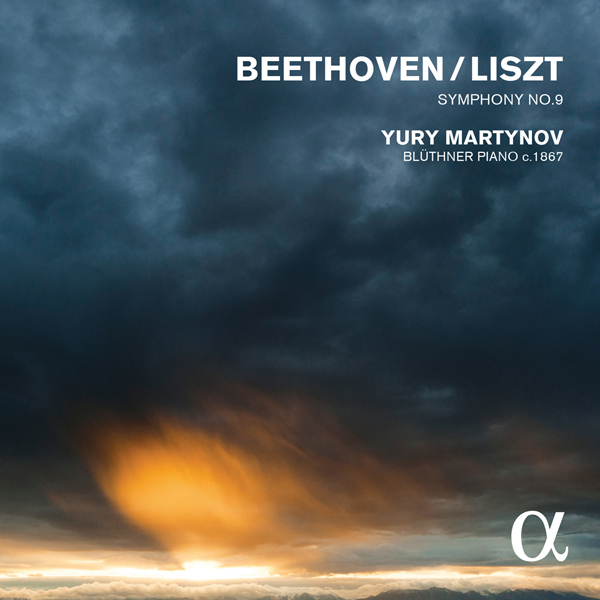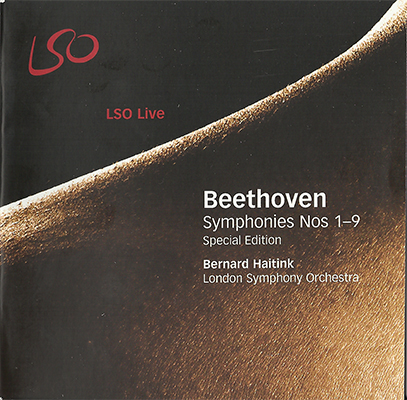
Beethoven-Liszt – Symphony No. 9 – Yury Martynov (2016)
FLAC (tracks) 24-bit/48 kHz | Time – 01:10:49 minutes | 606 MB | Genre: Classical
Studio Master, Official Digital Download – Source: Qobuz | Digital Booklet | © Alpha Classics / Outhere Music
Recorded: 21-25 September 2015 in Doopsgezinde Gemeente Church, Haarlem, Netherlands
After four previous discs devoted to Franz Liszt’s transcriptions of the Beethoven symphonies, the pianist Yury Martynov completes the cycle with the transcription of the Ninth Symphony. The reduction of this complex work for a single piano and two hands – he had already adapted it for two pianos – constituted a genuine challenge for Liszt, who was obliged to omit certain inner parts. Yet he succeeded in reproducing the symphony’s prodigious character and revealing its incredible power. The piano combines the orchestra, the soloists and the chorus, unifying these disparate voices in a single instrument. The work’s energy and its textures are displayed to the full in Yury Martynov’s performance on a Blüthner piano dating from 1867 and belonging to the Edwin Beunk collection.
All of Beethoven’s symphonies were transcribed for piano by Franz Liszt, starting in the 1830s and finally completing the project in 1864. As the booklet notes for this release point out, the Ninth presents particular challenges, and in 1851 Liszt at first resorted to his frequent solution of transcribing for two pianos, an alternative that has also appeared on recordings. The decisions on what to omit and how to convey a score for full orchestra, chorus and soloists on a single piano with two hands only boil down to Liszt giving priority to the orchestra. The booklet also identifies a number of points at which the transcription inventively maintains the power and energy of the original while seeming to leave out crucial parts. In the end it is as much the inner effect of Beethoven’s resourceful orchestration which is shown to create much of the vitality of that grand and famous finale. As ever, hearing this music in such an altered context reveals much that we probably knew subconsciously but had never really considered in detail.
The technical demands of this incredible finale are performed with supreme skill by Yuri Martynov, though we are by no means unaware of the difficulties. Part of what makes this recording stand out from the crowd is the decision to use an 1867 Blüthner piano. This would make little difference if this were a duff performance, but as it is Martynov is absolutely superb. The instrument has lighter sonorities and an upper register that ‘rings’ in a different way to modern instruments, but this heightened definition between the colours of lower, middle and upper ranges in fact does great things for Liszt’s elegant transcription of this complex masterpiece. The lower strings have real texture to their sound, to be sampled in their ‘solo’ from 14:36 into the last movement, and listening further from this point becomes an object lesson in the ways Liszt manipulates our perceptions of this familiar music – creating atmosphere and contrast through adding and subtracting, especially in his use of those upper octaves.
I’ve focused on the famous Finale, but this is by no means the only point of interest. Martynov’s touch in the mysterious opening to the whole work sets the scene for a fascinating and entertaining listen the whole way through. He manages to convey drama and excitement without making everything sound too melodramatic and ‘Hammer Horror’. The Molto Vivace second movement is also taken at a perfect pace – not too picky or measured but not too helter-skelter, the colours of the antique instrument creating believable orchestral sonorities. The Adagio molto cantabile has to move along on piano otherwise the melodic lines become lost, and at 16:00 total Martynov is both laudably sustained and sensibly paced. Most performances are a good few minutes shorter than this, and some miss out on a moment for real profundity and reflection as a result.
Yury Martynov’s previous recordings of the Beethoven/Liszt symphony transcriptions can be found on Zig-Zag Territoires (see reviews of the Second & Sixth, and First & Seventh). There are numerous alternatives to this recording of the Ninth, though most are performed on modern instruments. The Naxos complete Liszt edition has a very good recording by Konstantin Scherbakov (8.557366, see review), as they do with their Idil Biret Archive recording (8.571264-65) which might be a great choice were it not for several overly-weighty passages and a very slow first movement, coming in at over four minutes longer than Martynov. There are also several complete Beethoven/Liszt sets, including Leslie Howard’s vast edition on Hyperion (review), the Beethoven symphonies from which can be found in an excellent 5 CD set (CDA66671/5). Once again, we’re not comparing like with like, but it is fascinating to compare and contrast. To my mind Yury Martynov on his old Blüthner can stand amongst the best of any recordings on newer instruments, and as a performance in sounds that would have been home turf to its creator this has to be a leading choice. -Dominy Clements, MusicWeb International
Tracklist:
Ludwig van Beethoven (1770-1827)
Transcribed for Piano by Franz Liszt (1811-1886)
Symphony No. 9 in D Minor, Op. 125
1 I. Allegro ma non troppo, un poco maestoso 14:55
2 II. Molto vivace 14:29
3 III. Adagio molto e cantabile 16:00
4 IV. Finale (Presto) 25:25
Personnel:
Yury Martynov, piano
Blüthner piano, c.1867 (Edwin Beunk collection)
Download:




















![Beethoven-Liszt - Symphonies Nos. 7 & 1 - Yury Martynov (2013) [Qobuz FLAC 24bit/88,2kHz] Beethoven-Liszt - Symphonies Nos. 7 & 1 - Yury Martynov (2013) [Qobuz FLAC 24bit/88,2kHz]](https://getimg.link/images/imgimgimg/uploads/2017/03/pvf9SJM.jpg)
![Beethoven-Liszt - Symphonies Nos. 3 & 8 - Yury Martynov (2014) [Qobuz FLAC 24bit/88,2kHz] Beethoven-Liszt - Symphonies Nos. 3 & 8 - Yury Martynov (2014) [Qobuz FLAC 24bit/88,2kHz]](https://getimg.link/images/imgimgimg/uploads/2017/03/NpbXokS.jpg)
![Beethoven-Liszt - Symphonies Nos. 4 & 5 - Yury Martynov (2015) [Qobuz FLAC 24bit/48kHz] Beethoven-Liszt - Symphonies Nos. 4 & 5 - Yury Martynov (2015) [Qobuz FLAC 24bit/48kHz]](https://getimg.link/images/imgimgimg/uploads/2017/03/JxnxVAn.jpg)
![Maria Callas - Remastered The Complete Studio Recordings 1949-1969 (2014) [Qobuz FLAC 24bit/96kHz] Maria Callas - Remastered The Complete Studio Recordings 1949-1969 (2014) [Qobuz FLAC 24bit/96kHz]](https://getimg.link/images/imgimgimg/uploads/2018/12/Vw7IHlv-1.jpg)
![Carl Nielsen - Symphonies Nos. 1-6 - London Symphony Orchestra, Sir Colin Davis (2015) [Blu-Ray Pure Audio Disc + DSF Stereo DSD64/2.82MHz] Carl Nielsen - Symphonies Nos. 1-6 - London Symphony Orchestra, Sir Colin Davis (2015) [Blu-Ray Pure Audio Disc + DSF Stereo DSD64/2.82MHz]](https://getimg.link/images/imgimgimg/uploads/2015/09/Wnf48VE.jpg)
![Sir Simon Rattle, Berliner Philharmoniker - Jean Sibelius - Symphonies Nos. 1-7 (2015) [Blu-ray Disc + Pure Audio Blu-ray Disc + FLAC 5.1 24bit/192kHz] Sir Simon Rattle, Berliner Philharmoniker - Jean Sibelius - Symphonies Nos. 1-7 (2015) [Blu-ray Disc + Pure Audio Blu-ray Disc + FLAC 5.1 24bit/192kHz]](https://getimg.link/images/imgimgimg/uploads/2016/02/htbd2jO.jpg)

![Andras Schiff - Beethoven: Diabelli-Variationen, Op. 120 (2013) [HDTracks FLAC 24bit/44,1kHz] Andras Schiff - Beethoven: Diabelli-Variationen, Op. 120 (2013) [HDTracks FLAC 24bit/44,1kHz]](https://getimg.link/images/imgimgimg/uploads/2017/02/Zuaqo6e.jpg)
![Michael Tilson Thomas, The San Francisco Symphony - The Mahler Project (2010) [FLAC 24bit/96kHz] Michael Tilson Thomas, The San Francisco Symphony - The Mahler Project (2010) [FLAC 24bit/96kHz]](https://getimg.link/images/imgimgimg/uploads/2017/01/HHDTsz0.jpg)
![Pacifica Quartet - Dmitri Shostakovich and his Contemporaries: The Soviet Experience Vol. 1-4 (2011-2013) [24bit FLAC] Pacifica Quartet - Dmitri Shostakovich and his Contemporaries: The Soviet Experience Vol. 1-4 (2011-2013) [24bit FLAC]](https://getimg.link/images/imgimgimg/uploads/2017/07/ntIbtOp.jpg)
![Glenn Gould - The Complete Columbia Album Collection (2015 Remastered Edition) [Qobuz FLAC 24bit/44,1kHz] Glenn Gould - The Complete Columbia Album Collection (2015 Remastered Edition) [Qobuz FLAC 24bit/44,1kHz]](https://getimg.link/images/imgimgimg/uploads/2017/07/2bHwfbA.jpg)
![Itzhak Perlman - The Complete Warner Recordings 1972-1980 (2015) [FLAC 24bit/96kHz] Itzhak Perlman - The Complete Warner Recordings 1972-1980 (2015) [FLAC 24bit/96kHz]](https://getimg.link/images/imgimgimg/uploads/2019/12/IpmBmeR.jpg)
![Alexandra Dariescu & Lindsey Russell - The Nutcracker and I (2018) [FLAC 24bit/96kHz] Alexandra Dariescu & Lindsey Russell - The Nutcracker and I (2018) [FLAC 24bit/96kHz]](https://getimg.link/images/imgimgimg/uploads/2019/10/kRyxJUd.jpg)
![Martin Haselbock, Orchester Wiener Akademie - Liszt: Hungarian Rhapsodies (2013) [Qobuz FLAC 24bit/96kHz] Martin Haselbock, Orchester Wiener Akademie - Liszt: Hungarian Rhapsodies (2013) [Qobuz FLAC 24bit/96kHz]](https://getimg.link/images/imgimgimg/uploads/2017/09/MwHY0vf.jpg)
![Netherlands Radio Philharmonic Orchestra, James Gaffigan, Ingo Metzmacher, Christoph Poppen, Michael Schonwandt, Markus Stenz, Osmo Vanska - Karl Amadeus Hartmann: Symphonies Nos. 1-8 (2014) [nativeDSDmusic DSF DSD64/2.82MHz] Netherlands Radio Philharmonic Orchestra, James Gaffigan, Ingo Metzmacher, Christoph Poppen, Michael Schonwandt, Markus Stenz, Osmo Vanska - Karl Amadeus Hartmann: Symphonies Nos. 1-8 (2014) [nativeDSDmusic DSF DSD64/2.82MHz]](https://getimg.link/images/imgimgimg/uploads/2019/01/xUV4HwU.jpg)